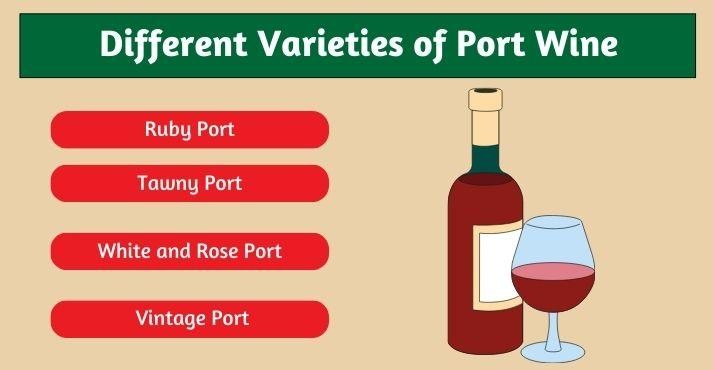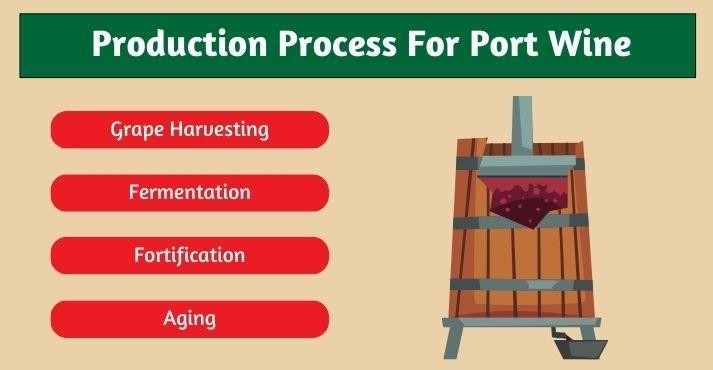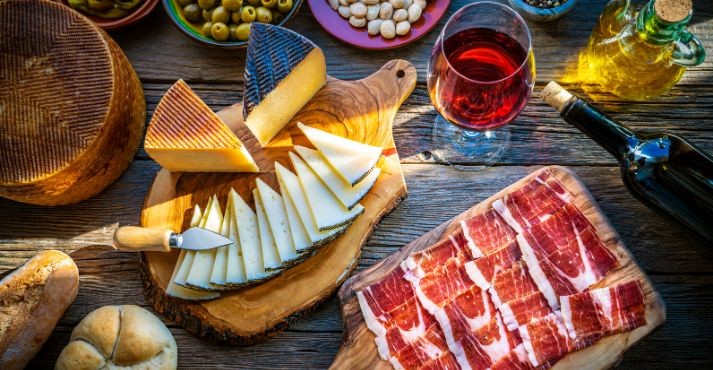Have you ever wondered why Port wine stands out with its intense flavors and higher alcohol content? Originating from the Douro Valley in Portugal, Port is a unique fortified wine renowned for its rich sweetness and versatility.
Known widely as a dessert wine, Port wine is available in diverse styles, each with distinct characteristics.
This glossary provides an in-depth look at port wine, from its unique production methods to various styles and ideal wine-food pairings. Use this guide to explore the world of Port wine, developing your knowledge and appreciation of this iconic drink.
What is Port Wine?
Port wine is a fortified wine produced in Portugal’s Douro Valley. Its sweetness and high alcohol content characterize it. Port is made by adding grape spirit (aguardiente) during fermentation, which halts fermentation early, preserving natural sugars.
Known for its robust flavors, Port wine is often enjoyed as a dessert wine or served with cheese—fortification results in a balanced sweetness and strength that sets Port apart from other wines. Depending on the style, it ages in wood and bottle, each with unique development.
History of Port Wine
Origins in the Douro Valley, Portugal
The story of Port wine dates back centuries to the Douro Valley, where grape varieties and terraced vineyards have been carefully cultivated. The region’s climate, soil, and rugged terrain make it ideal for producing Port, creating wines of remarkable character.
Role of British Merchants
British merchants played a key role in popularizing Port wine. In the 17th century, they began fortifying the wine with grape spirit to ensure stability during transport. This practice resulted in the distinct fortified wine style we recognize today, and Port quickly gained popularity across Europe.
Evolution of Port Wine Production
Port wine production has evolved over the centuries with refined fermentation, fortification, and aging techniques. Today, various aging methods contribute to Port’s complexity, from cask-aged Tawny to bottle-aged vintage Port, each adding unique qualities to the wine.
Different Styles of Port Wine

Port wine is celebrated for its wide range of styles, each offering a unique taste experience influenced by varying aging processes and production techniques.
From the vibrant fruitiness of Ruby Port to the complex, nutty characteristics of Tawny Port, each style is crafted to highlight specific flavors and aromas. The diverse types of this natural wine provide something for every palate, whether you prefer a young, fresh wine or an aged, refined one.
This section explores the primary styles of Port, helping you understand the unique qualities that make each one distinct.
1. Ruby Port
Definition: Ruby Port is a bold, fruit-forward style known for its deep red color and fresh, vibrant flavors. It is aged briefly in large vats to retain its youthful qualities.
Flavor Profile: Ruby Port features cherry, raspberry, and plum notes. It’s often served as an after-dinner drink and is one of the most accessible types for new Port wine drinkers.
Food Pairing: Pairs beautifully with berry desserts, chocolate-based treats, and mild cheeses.
2. Tawny Port
Definition: Tawny Port is aged in wooden casks, allowing oxidation that imparts a golden-brown hue and develops flavors of dried fruit, caramel, and nuts.
Flavor Profile: Tawny Port is smooth, layered, and complex, with hints of caramel, figs, and almonds. It can be labeled by age (10, 20, 30, or 40 years), with older Tawnies showing more depth.
Food Pairing: Pairs well with desserts like crème brulee, nut-based pastries, and blue cheeses.
3. White and Rose Port
Definition: White Port is made from white grapes, while Rose Port is crafted with a lighter, fruitier profile. These are unique alternatives to traditional Port.
Flavor Profile: White Port offers flavors of almond, honey, and citrus, while Rose Port has notes of red berries and floral elements, offering a refreshing taste.
Food Pairing: It is ideal for cocktails or enjoyed chilled with light appetizers like olives, almonds, or smoked fish.
4. Vintage Port
Definition: Vintage Port is produced from the highest quality grapes in a single declared year. It is bottled after two to three years of aging in casks, intended to age for decades in the bottle.
Flavor Profile: Vintage port is considered one of the most prestigious types of port, known for its concentrated flavors of dark fruit, spice, and earthy notes.
Food Pairing: Pairs well with rich cheeses like Stilton and can be enjoyed as an after-dinner indulgence.
Additional Port Styles
Beyond the well-known categories of Ruby, Tawny, and Vintage, Port wine offers several other unique styles, each adding depth to the diverse Port family.
These variations, like Late Bottled Vintage (LBV) and Single Quinta Port, bring unique flavor profiles and aging methods that showcase the creativity and heritage behind Port production.
These additional styles often bridge the gap between classic Ruby and Tawny, offering new ways to enjoy Port for every occasion and preference. This section introduces you to these distinct types, expanding your appreciation of the complexity and versatility of Port wine.
1. Late Bottled Vintage (LBV)
Definition: LBV Port is from a single vintage, aged longer in wood (typically four to six years) than Vintage Port before bottling. It offers a mature, refined character with accessible pricing.
Flavor Profile: LBV has flavors of black cherry, plum, and dark chocolate, with smoother tannins than traditional Vintage Port.
Food Pairing: Complements dark chocolate, rich desserts, and hard cheeses.
2. Single Quinta Port
Definition: A Port produced from grapes from a single estate or quinta. Often released in non-declared vintage years, Single Quinta Ports offer high quality at a more affordable price.
Flavor Profile: Balanced flavors reflect the estate’s terroir, including dark fruits and spice.
Food Pairing: Great with roasted meats, aged cheese, or enjoyed as a sipping wine.
Port Wine Production Process

The production of Port wine is a thorough process that blends tradition, skill, and the unique terroir of Portugal’s Douro Valley. From carefully selected grape varieties to the distinct fortification technique, each step contributes to Port’s rich, complex flavors and high alcohol content.
This process includes grape harvesting on steep, terraced vineyards, a shortened fermentation period, and a unique method of fortification with grape spirit (aguardiente) that creates Port’s signature sweetness.
Aging further shapes each style, with Ruby, Tawny, and Vintage Ports following a different aging path. Here, we break down the critical steps in producing this legendary fortified wine.
1. Grape Harvesting
The Douro Valley’s challenging terrain and climate are crucial to Port wine production. This region’s terroir, with its hot summers, cold winters, and unique soil compositions—provides ideal growing conditions for Port’s distinctive grape varieties.
Essential grapes include Touriga Nacional, known for its intensity and complexity; Touriga Franca, which adds fruitiness and aromatic depth; and Tinta Roriz (known elsewhere as Tempranillo), which lends structure and body to the wine.
Harvesting is typically done by hand in late summer in the Douro Valley’s steep, terraced vineyards. This careful, labor-intensive approach ensures that only the ripest grapes are selected, preserving the quality needed for Port wine.
Once harvested, the grapes are transported to the winery, where they are gently crushed to begin fermentation. The quality of the grapes at this stage plays a significant role in the final Port wine’s overall character and flavor profile.
2. Fermentation
Fermentation is the stage where the sugars in the crushed grapes are converted into alcohol through the action of yeast. In Port wine production, fermentation is intentionally shortened.
As the grape must (crushed grapes and juice) begins to ferment, the sugars start to turn into alcohol, but the process is halted earlier than in standard wine production.
This early interruption is critical to maintaining the natural sugars that give Port wine its signature sweetness.
The decision to halt fermentation is precisely timed and is influenced by the initial sugar levels of the grape must, the style of Port being produced, and the winemaker’s preference. The result is a wine that retains both sweetness and complexity, setting it apart from other types of Port wine.
3. Fortification
The fortification process truly distinguishes Port from other wines. To stop fermentation and preserve the wine’s natural sugars, a neutral grape spirit known as aguardiente is added to the wine. This addition raises the alcohol content to around 19-22%, resulting in a stronger, richer wine.
Fortification halts fermentation and influences the wine’s flavor and texture. When preserving residual sugars, Port wine is given its characteristic sweetness. Additionally, fortification helps stabilize the wine, allowing it to develop complex flavors during aging.
This step requires great skill, as the timing of fortification can impact the final product’s balance between sweetness, alcohol, and acidity.
4. Aging
Aging is the final step in the Port wine production process and dramatically influences the wine’s flavor, color, and texture. Different styles of Port follow distinct aging methods:
- Ruby Port: Aged in large vats, Ruby Port is kept from extensive exposure to oxygen, preserving its deep red color and fresh, fruity flavors. This shorter aging process maintains Ruby’s vibrant, youthful character, making it ideal for those who enjoy a more straightforward, fruit-forward wine.
- Tawny Port: Aged in smaller oak casks, it undergoes oxidation and evaporation, gradually lightening its color and deepening its flavor. Over time, Tawny develops a rich, amber hue and complex notes of caramel, nuts, and dried fruits, giving it a smooth, layered taste. Tawny Ports are often labeled with the length of aging, such as 10, 20, 30, or even 40 years, with each aging tier offering increasing depth and sophistication.
- Vintage Port: Produced only in exceptional years, Vintage Port ages in bottles after a short initial period in casks. This style is known for its intensity and potential for long-term aging, often developing for decades in the bottle. Vintage Ports acquire complex flavors of earth, spice, and dark fruit as they mature, making them highly sought after by collectors.
Each aging method contributes unique characteristics to the wine, shaping the specific types of Port wine consumers enjoy. Aging in vats, casks, or bottles transforms the flavor and aroma and gives Port wine depth, richness, and adaptability to various preferences.
Essential Terms in Port Wine
Let’s explore some wine terms that are relevant to Port wine.
Aguardente
Aguardente is a distilled grape spirit added during fortification to Port wine. It halts fermentation by killing yeast, preserving the wine’s natural sugars.
Pipe
A traditional Portuguese barrel with a capacity of about 550 liters is used for aging port wine. Pipes contribute to the wine’s maturation and flavor development.
Quinta
Portuguese term for vineyard estate. Many Ports are produced by specific quintas, adding unique character based on the vineyard’s location and grape varieties.
Reserva
A premium Port category often indicates higher quality within a specific style, such as Ruby or Tawny.
Tasting Port Wine
Acidity
Port wines typically have moderate acidity, which balances their sweetness and richness.
Body
Port wine is generally full-bodied, offering a rich mouthfeel due to its high alcohol content and sweetness.
Finish
Port wines often have a long, lingering finish with evolving flavors, especially in aged styles.
Pairing Port Wine with Food

Port wine pairs well with a variety of foods. Here are some popular pairings:
- Cheese: The sweetness of Port balances well with salty cheeses like blue cheese, aged gouda, and manchego.
- Chocolate: Port’s rich, fruity flavors complement dark chocolate desserts, enhancing the wine and the chocolate.
- Fruit-Based Desserts: Ruby and Tawny Ports pair nicely with berry desserts, apple tarts, and fig-based dishes.
- Savory Dishes: Tawny Port pairs beautifully with roasted meats, duck, and savory pastries, offering a delightful balance of flavors.
Conclusion
Port wine is a rich and storied drink with various styles and flavors to suit any palate. From the deep red ruby and complex Tawny to the prestigious vintage Port, each type of fortified wine offers a unique experience shaped by its production, aging, and terroir.
With this glossary, wine enthusiasts can genuinely understand Port wine, explore its history, flavors, and perfect pairings for Port wine, and gain a deeper appreciation of this iconic drink from Portugal’s Douro Valley.
As it can be enjoyed as a dessert wine or a luxurious evening sip, Port wine continues to enchant and inspire worldwide.





























